Common Chimney Problems
We are Independent Building Surveyors
We are highly qualified Independent Building Surveyors meaning we are not attached to any bank, building society or estate agent. We can offer you building surveys (also known as Structural Surveys), engineer's reports and home buyers reports. We also do Specific Defects Reports on such things as chimney problems, dampness, cracking and much more. We can also carry out Independent Valuations but please note these are not for bank lending but are to advise you how much we feel the property is really worth.
Please free phone us on 0800 298 5424 for a friendly chat.
Chimneys, out of sight out of mind
Chimneys are situated at roof level and above and are exposed to everything the weather can throw at them. Ironically, they are no longer generally used as they once were for the main fire of the house but more likely to be used either as a boiler flue or a flue to a feature fire. Deterioration to the chimney can still result in, at best, dampness coming into the property and, at worst, the chimney collapsing.
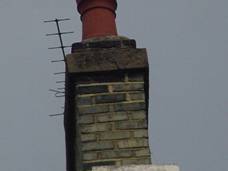
Why are chimney stacks called chimney stacks?
This is literally because they are a stack of bricks and stone, which is the only logical way to build in these materials of any height, i.e. they cannot be built diagonally, and this is why chimneys are lined up within a property
Chimneys, some background information

Chimneys were once the latest mod con to have. Developed in their present form in the 17th Century, prior to that there being fires literally in the middle of the floor with smoke passing up into the roof, which was sometimes vented, sometimes not!
If you visit the Weald and Downland Museum Open Air Museum in Singleton, West Sussex Wikipedia says the following: The museum covers 50 acres (20 hectares) with nearly 50 historic buildings dating from the 13th to 19th Centuries along with gardens, farm animals, walks and a lake. The buildings at the museum were all threatened with destruction, they were carefully dismantled, conserved and rebuilt in the original form at the museum. These buildings help the museum bring to life the farms, homesteads and rural industries of the last 700 years. It is a nice day out as well. A good place to see the history of the chimney!
Spotting old chimneys
If you look at older properties you will see that many of them have had the chimneys added on in a different material; often brick or stone in Tudor properties. This was because in days gone by people were much more adaptable and flexible in the way they built houses and if it didn't have something they required they would re-build or extend or adapt part of the house. This was the case when chimneys were the latest mod con
Chimneys come in many shapes and sizes
Over the years we have come across chimneys in many shapes and sizes. Whilst more modern properties tend not to have a chimney, or a mock chimney, a fireplace can be the centre piece of many older properties.
Older style chimneys/Inglenook fireplaces
Probably the most common older style fire seen is an inglenook fireplace. Normally problems occur to the chimney breast with weathering as chimneys are so exposed. Over the time, to put it simply, the weather simply wears them out and they need repairing and repointing.

An inglenook fireplace as you see it
from your front room
However, we have recently come across an inglenook fireplace that had completely collapsed, falling internally, although it didn't photograph very well.
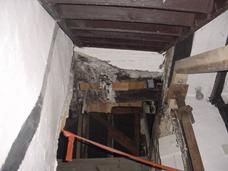
Looking up towards the roof
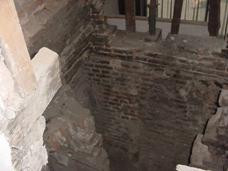
Looking down towards the ground
Large chimneys
Large ornate chimneys tend to be brick. Their sheer height means they are susceptible to deterioration, particularly where there is a softer red brick that has been used and the bricks tend to weather, as well as the pointing. They were particularly popular during the Tudor period and were very decorative, but any large chimney can be problematic as it simply is in such an exposed location.
Always have a lead flashing
We would always recommend for chimneys that the flashings are lead. More modern times meant mortar or tiles on edge have been used rather than a lead flashing, which are never as good. Flashings are meant to form a barrier at the junction where the chimney meets the roof and does need some flexibility as the chimney and roof structure move at slightly different rates. This tends to cause cracking where cement or a tile on edge mortar has been used.
Repair with cement mortars
On all but the most modern brickwork a cement mortar was used. This is because the cement mortar is hard and doesn't allow any rainwater to travel along the joint but rather discharges it down the brickwork, which in turn causes deterioration to the face of the brickwork.

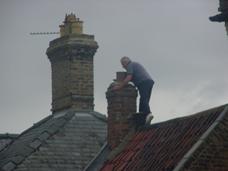
Why have one of our independent building surveys?
Caveat emptor means buyer beware and is why we feel a building survey is essential. Properties can come with all sorts of problems and not just chimney problems. The estate agent certainly will not advise you of any problems with the property but we most definitely will!
Remember the Building Surveyor that you employ will be the only person working for you with your interests at heart.
We have developed our surveys over many years and have listened to feedback from our clients and we continue to listen. We believe our surveys are easy to understand and describe issues clearly.
Why do we include sketches and photos in our surveys and what are the red circles and ovals?
As you can see from this article we use lots of photos and sketches to explain things pictorially. The feedback we have over the years from our clients is that the sketches and photos that we use help them understand our reports better and in turn their better understanding ensures that they know the problems or issues that the property has and as such they can negotiate with regards to price on this matter or make allowances and budget for future work.
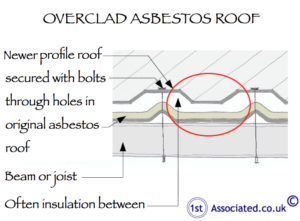
An example of one of our sketches
Meet our surveyor at the property
We are more than happy to meet you at the property during the survey to discuss any issues you have and we are more than happy to walk around the property and show you our findings. Please free phone 0800 298 5424 for a friendly chat with one of our surveyors.
Please contact us for help and advice on chimneys, surveys, building surveys, structural reports, engineers reports, specific defects report, structural surveys, home buyers reports or any other property matters on 0800 298 5424 and a surveyor will ring you back to discuss this further.
Commercial Property
If you have a commercial property and would like help you may also wish to visit our dilapidations website www.DilapsHelp.com and for Disputes go to our Disputes Help site www.DisputesHelp.com .
Our articles
We hope you found the article of use and if you have any experiences that you feel should be added to this article that would benefit others, or you feel that some of the information that we have put is wrong then please do not hesitate to contact us (we are only human).
The contents of the web site are for general information only and are not intended to be relied upon for specific or general decisions. Appropriate independent professional advice should be paid for before making such a decision.
Our rights
All rights are reserved the contents of the website are not to be reproduced or transmitted in any form in whole or part without the express written permission of www.1stAssociated.co.uk
